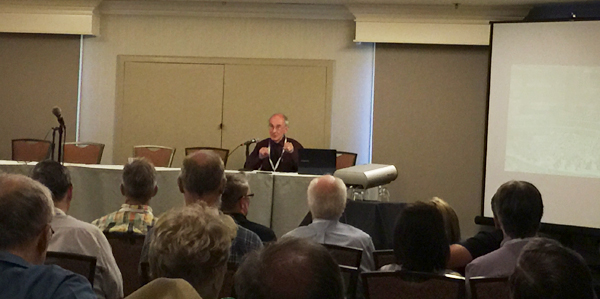Reference Recordings and Keith Johnson
I’ve known Keith Johnson for many years. We met at an AES convention and while we’ve not seen each other in a very long time, I hold him in the highest regard. So it was a very great pleasure to attend his presentation at the California Audio Show 2015 and have a chance to chat with this master engineer afterwards.
Here’s a brief bio from the Reference Recordings website:
“Prof.” Keith Johnson has spent over 30 years developing a reputation for innovative thinking, technical achievement and musicianship which has elevated him to a position in the audio industry occupied by only a handful of visionaries. His intensive investigation of electronic behavior and acoustic perception have led most recently to his development (with digital engineer Michael Pflaumer) of the revolutionary High Definition Compatible Digital encoding process, produced and marketed by Pacific Microsonics (recently acquired by Microsoft). HDCD is widely considered to be the most accurate recording process ever invented.
For more than 30 years, Keith O. Johnson has served as Technical Director, Recording Engineer and partner in Reference Recordings. His 100-plus recordings for the label have long been considered the standard for high fidelity, and include three GRAMMY award-winners and eight additional GRAMMY nominations.
Keith is also a musician, inventor, and a runner…I like him a lot.
His presentation started with an explanation of how our human hearing functions. He described all of the active components and made special mention of the permanent damage that can be done to your inner ear by listening too loud. He discussed the critical effects that recording venues have on the ultimate sound of a recording. Keith does a lot of classical orchestral recordings and brings his custom gear to the venues. His years of experience allow him to narrow in on the “best” placement of few microphones…some spaced pairs and others in Blumleim configuration.
Figure 1 – Professor Keith Johnson at his presentation at the CAS6 event.
An article on MixOnline states:
“He models his setup after one used by longtime engineer Gordon Parry of London Decca Classical, using EQs on only four inputs, each optimized for a specific task: woodwinds, brass, voice and reverb. Mics include a pair of front omnis, a pair (or more) of semi-directional outriggers on either side, random incident omni pairs to capture hall reverb, ribbon or large-diaphragm condensers for solo instruments and a directional center group between the omnis. “The main and center group are 90 percent of what you hear,” says Johnson. “But I add what I call ‘time-panned stereo pair accents’ to produce delays simulating inter-aural binaural listening.”
Keith and I have decidedly different approaches to capturing the sound of an acoustic event…classical or otherwise, but I love the open and full sound of his productions. He’s a true master and has had a great influence on engineers in audiophile recording circles.
Having some time with Professor Johnson made the weekend very special.



Mark,
A good blog on KOJ. Reference Recordings have always been my benchmark for sound quality on LP, CD and HDA. Don’t forget the design work he does for Spectral Audio..
V
More than one recipe for baking a great tasting cake. 🙂
Hi, Mark – Nice to see you there at CAS-6 in SF over the weekend. As I mentioned to you, I appreciate your continuing commitment to “fighting the good fight” to raise the level of digital sound quality and to require real proof for all the mystical, paranormal (and, sometimes, outright ignorant) claims and thinking that afflict high-end audio.
I attended Prof Johnson’s lecture too and was amazed at some of the details he goes into for preparation of a recording, which include studying the score itself to get an idea of the possible difficulties he may encounter in recording a particular piece of music. It went a long way towards explaining how he achieves the fine results he achieves with his reference recordings.
I also attended your lecture the previous day, and, needless to say, it was a real breath of fresh air (even though I was already familiar with your views from your daily blog here). I know that such efforts often require considerable expenditures of time on your part, and I just wanted to say that they’re very much appreciated!
I like both Keith Johnson’s approach and AIX approach, though they are very different. To a non-audio engineer, I would say that the Johnson experience, as exemplified in his Reference Recordings, is an attempt to simulate something of the experience of a concert goer in an audience, with all its benefits and drawbacks. The AIX exerience involves a bit more creativity, in a certain sense, the way instruments and sections are miked and mixed.
Interesting, I found that went I went to Tanglewood for the first time, I was sceptical about the amplification they used, and also the video screens aimed at concertmaster or different sections of the orchestra. I found that the end effect was excellent, very interesting, and too my liking. But it certainly was diferent from what I would hear at Symphony Hall or Carnegie Hall. So, in sum, these, like Tangelwood, are both viable and admirable ways of recreating (or creating) a concert experience and I like them both.